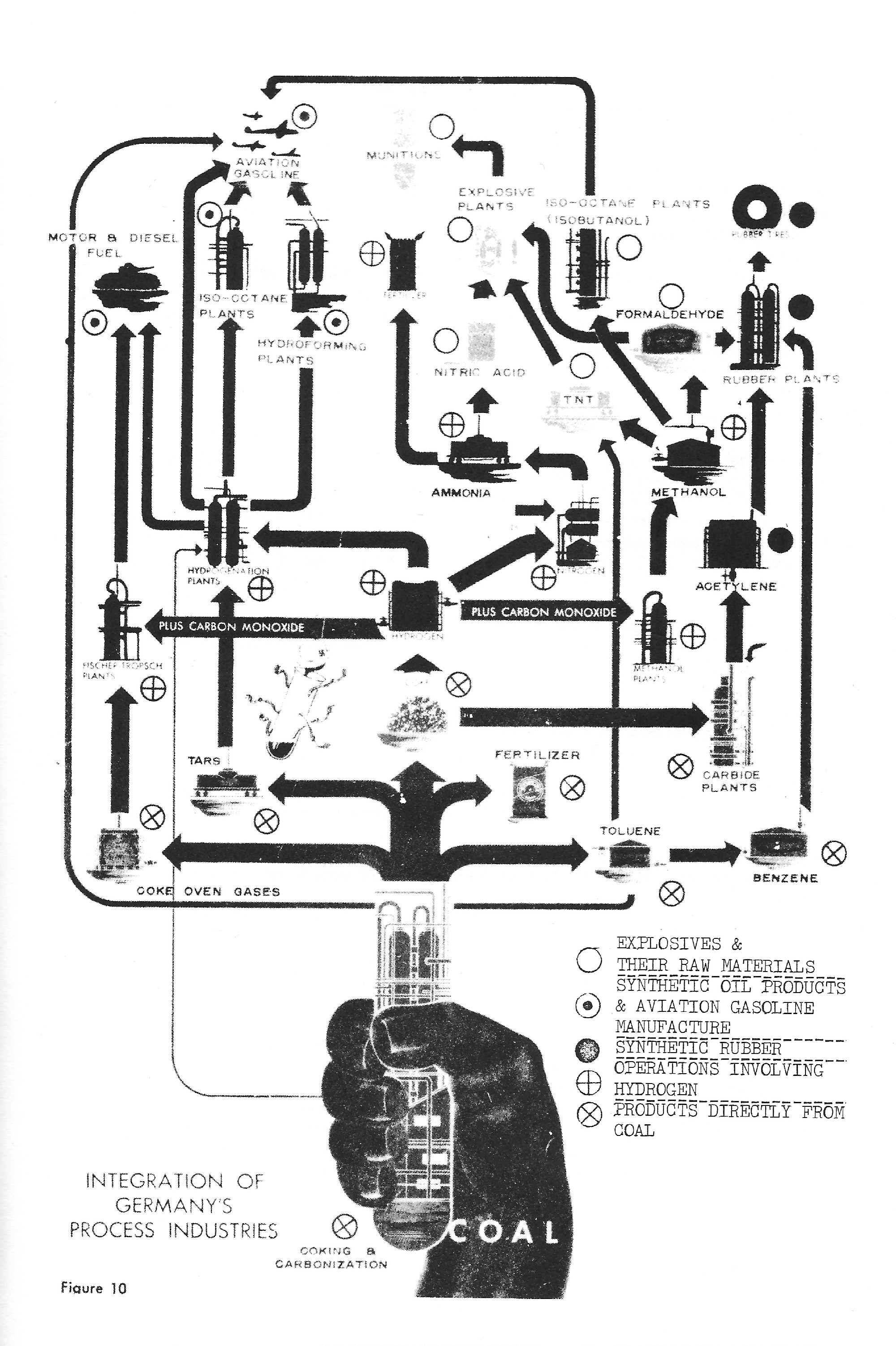The Magnifying Glass
In the autumn of 1945, Report #109, Oil Division of the United States Strategic Bombing Survey featured a diagram of the coal chemistry of Germany, in which technological, world and geological history were combined. The report describes the effects of the bombardments on German industry. With shuddering fascination, the United States Commission reported on the Nazi German chemicals industry as an “industrial octopus,” which, based on coal, air and water, had devastated an entire continent. In fact: One can literally make anything and destroy almost everything merely by the industrial combination of enough carbon and hydrogen.
As much as the diagram depicts an end, it also illustrates a beginning because the processes developed for coal chemistry are precisely those that have developed global efficacy in the petrochemical industry as well. As history shows, synthesis – or the dialectical union of contradictory quantities, even antagonistic ones, into a new whole – becomes tangible on the macro and micro level in the historical as well as in the common, chemical sense of the word.
I.G. Farben, Standard Oil and the Nazi Party
It is incorrect to assume that the coal chemistry and petrochemical industries only united after 1945. The monster itself would not have existed at all had the American and German oil and coal chemistry sectors not been linked together since the 1920s.
Ironically, Standard Oil of New Jersey had saved I.G. Farben’s plan – which had nearly failed due to its horrendous costs – to make gasoline from domestic coal. For if even stubborn coal can be hydrogenated to gasoline, they deduced, surely oil residues could also be refined, yielding fabulous margins. Indeed, by merely distilling crude oil, hydrocarbon molecules can be chemically (re-)combined and synthesized. From 1929, hydrogenation plants were built in Louisiana and Leuna with common patents and shares. However, the appearance of another adversary ensured that the transatlantic business partners would find themselves, a few years later, on opposing sides of the Second World War’s Axis of powers.
At the beginning of the 1930s, the Nazi Party agitated against I.G. Farben. Company boss Carl Bosch was denounced as a liberal. Yet here, too, enemies became fatal allies. With the “Gasoline Agreement” of 1933, I.G. Farben hoped to gain guarantees of sales for synthetic fuel, which was still prohibitively expensive on the world market, in exchange for linking the group’s interests with the Nazi regime of terror and production facilities in Auschwitz. Only the war would halt this alliance.
Dialectically Synthetic Catalysts
The synthesis of former antagonists also decided the chemical level. The central technical principle here is catalysis; that is, the control and acceleration of chemical processes by substances involved in the reaction but not contained in the final product.
At the beginning of the twentieth century, not only precious metals such as platinum, but also synthetic catalysts composed of several elements were used to synthesize substances such as ammonia for artificial fertilizers and ammunition.
Dialectical catalysts demonstrate the hydrocarbon industry’s innovative stance. For example, if sulfur contained in coal or oil “contaminated” the hydrogenation, catalysts specially treated with sulfur could process coal and oil. The problem, therefore, must become part of the solution, the I.G. Farben chemists thought in around 1924. An iron oxide catalyst was processed with hydrogen sulfide to Fe2S3, and this turned out to be contaminant-proof. Like a double agent, the sulfur turns and works from then on for, rather than against, the catalyst. This laid the foundation for generations of coal and petrochemical processes.
The integration of the coal and petrochemicals industries. A diagram, from the United States Strategic Bombing Survey (ed.), Oil Division, Final Report (European Report #109), The United States Strategic Bombing Survey Oil Division, volume V. New York and London: Garland 1976, Fig. 10.
The Molecular and Planetary Technosphere around 1948
Manipulation at the molecular level has an effect at the planetary level. In around 1948 and thereafter, the effect on the technosphere saw not only human beings or merely raw materials in the hands of human beings make history: for that which was made with dialectically synthetic catalysts had a historical as well as geohistorical potency as well.
In around 1945, the cornucopia was neither half-full nor half-empty. It was just beginning to bubble. The well-engineered processes had reliable, permanent supplies. In the years after the war, oil overtook coal as modernity’s paradigmatic raw material. It was no longer a problem of taming demand but also tempering the surplus. Limousines with oversized engines, oil used in all spheres of life via plastic, resource-hungry lifestyles, all were developed specially in order to guarantee growth in petroleum-based economies.
The history of this industry demonstrates that global effects by no means begin abruptly with novel inventions. Instead, dynamics, which have accumulated over decades, reach a supercritical mass at some historical point. It is as if several waves coming from different directions had converged, so that their combined force rises at some point. At the Great Acceleration – that global acceleration of all possible parameters between transport and production, erosion and species extinction after 1950 – this wave would continue to grow in force for a long time into the future.
The Energy Transition
Ocean liners and aircraft cannot run on batteries alone. The need for storage of molecular energy will continue. A technosphere that has learned to tailor molecules based on fossil resources will need to relearn and then continue its learning. However, an even more complex catalytic chemistry would be capable of storing a sustainable electricity supply in artificial molecules. Yet, even today, this utopian cornucopia of sustainable energy production, and other innovations would not exist without the paradoxical cornucopia of 1945.
